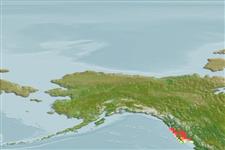Environment: milieu / climate zone / depth range / distribution range
Ecologie
marien demersaal; diepte 0 - 95 m (Ref. 50550). Boreal; 56°N - 52°N, 156°W - 128°W
North Pacific: Commander and Aleutian islands to British Columbia, Canada.
Grootte / Gewicht / Leeftijd
Maturity: Lm ? range ? - ? cm
Max length : 30.0 cm TL mannelijk / geslacht onbekend; (Ref. 2850)
Inhabits rocky areas (Ref. 2850). Retreats into a hole or crevice (Ref. 2850).
Levenscyclus en paargedrag
Maturiteit | Voortplanting | Paaien | Eieren | Fecunditeit | Larven
Eschmeyer, W.N., E.S. Herald and H. Hammann, 1983. A field guide to Pacific coast fishes of North America. Boston (MA, USA): Houghton Mifflin Company. xii+336 p. (Ref. 2850)
Status op de Rode Lijst van het IUCN (Ref. 130435: Version 2024-1)
Gevaar voor de mens
Harmless
Gebruik door de mens
Tools
Speciale rapporten
Download XML
Internetbronnen
Estimates based on models
Preferred temperature (Ref.
123201): 8.2 - 9.7, mean 9.2 °C (based on 32 cells).
Fylogenetische diversiteitsindex (Ref.
82804): PD
50 = 0.5703 [Uniqueness, from 0.5 = low to 2.0 = high].
Bayesian length-weight: a=0.00389 (0.00180 - 0.00842), b=3.12 (2.94 - 3.30), in cm total length, based on all LWR estimates for this body shape (Ref.
93245).
Trofisch niveau (Ref.
69278): 3.7 ±0.3 se; based on size and trophs of closest relatives
Weerstandsvermogen (Ref.
120179): Gemiddeld, minimale populatieverdubbelingstijd 1,4-4,4 jaar (Preliminary K or Fecundity.).
Fishing Vulnerability (Ref.
59153): Low vulnerability (20 of 100).
